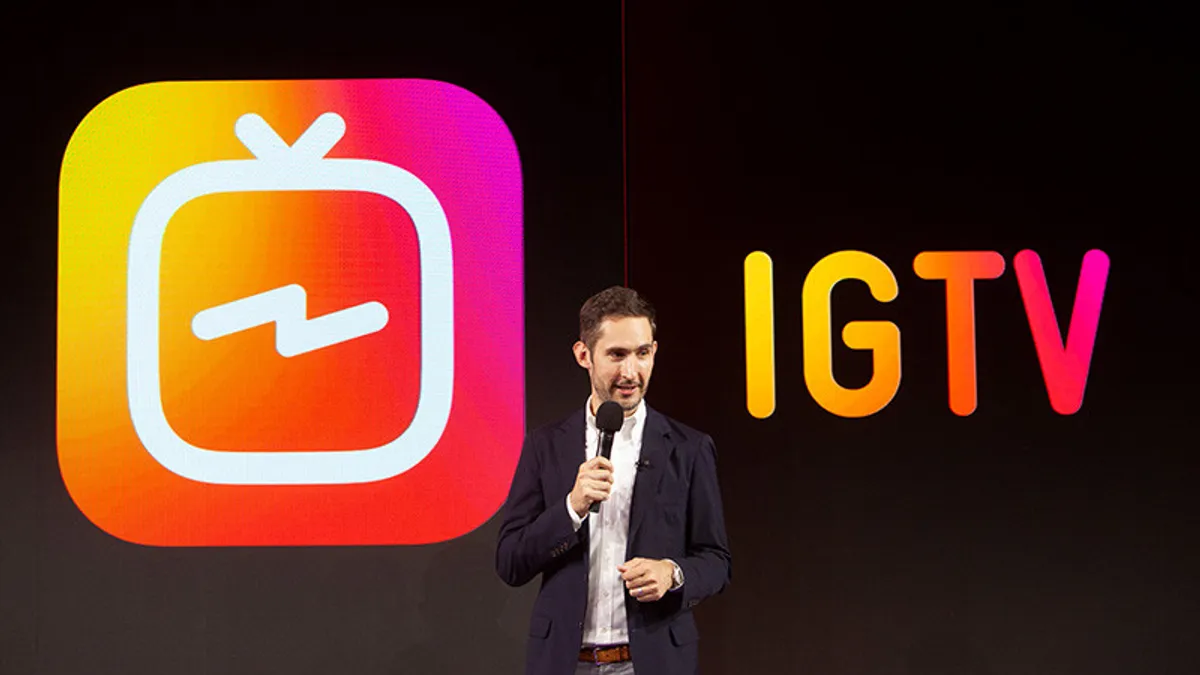The following is a guest post from Adam Williams, CEO of Instagram influencer marketing service Takumi. Opinions are the author's own.
"It's time for video to move forward and evolve," announced Instagram CEO Kevin Systrom at IGTV's June 2018 launch in San Francisco. Introduced in tandem with Instagram hitting 1 billion users, IGTV was developed as an innovative standalone app and extension to Instagram to exclusively support long-form vertical video content.
With 90% of marketers choosing to invest in Instagram to promote their products, it goes without saying that the platform has gone from strength to strength since its launch in 2010. Continually evolving to meet the demands of ever-curious and creative consumers, Instagram has introduced a host of innovative features, namely its Stories function, which took off rapidly and was arguably a significant contributor to Snapchat's user numbers declining.
In 2018, Instagram reported that its users watched 60% more video than in 2017, and in January of this year, figures showed Stories are used by 500 million users every day — half of Instagram's user base.
Backed by Systrom's confidence in Instagram's continued growth and the demand for video content, IGTV was expected to follow in the same vein as its highly successful parent platform. However, Instagram's video function didn't quite get off to the flying start Systrom and his team had hoped for.
Early adoption
One of the predominant factors that contributed toward IGTV's uncertain beginnings was media speculation and skepticism around whether it would could compete with YouTube. Many content creators were hesitant to embrace the new offering, and in true influencer style, took to polling their audiences for answers. Should they explore new territory or stick to the tried and tested waters of YouTube?
Vertical video was IGTV's unique selling point, though momentum never really picked up, as the added effort of creating vertical video in addition to YouTube's horizontal format proved a turnoff for content creators.
From a marketing perspective, YouTube's easy-to-digest reporting was enough to convince brands not to stray; its advanced analytics help brands to easily determine what does and doesn't work for their target audiences. On the other hand, IGTV is slightly trickier to analyze, given that Instagram followers are automatically subscribed to corresponding video channels. This makes it difficult to determine whether IGTV audiences exist by default through following an influencer's main Instagram feed, or whether their audience has chosen to follow solely for IGTV content.
Nonetheless, despite a hesitant initial reception, a handful of brands and influencers embraced IGTV, using it to post exclusive content, repurpose existing videos or develop a recurring "broadcast" segment.
Musician John Mayer uses Instagram's video feature to host his own talk show, "Current Mood," a 45-minute program featuring VIP guests from the music industry. Mayer has done what most others were afraid to and has made the leap, tapping into IGTV's potential to bring his audience original and engaging content.
Room for improvement
What IGTV has done successfully is increase engagement with existing followers. The hurdles have been in attempting to draw new users to the platform.
Like Mayer, Instagram demonstrates its faith in IGTV by taking initial feedback and improving its offering. Earlier this year, two important adaptions were introduced, instantaneously enhancing IGTV's appeal.
In February 2019, the first change gave creators the ability to publish one-minute previews of channel videos in their main Instagram feeds, encouraging followers to click through and continue viewing content on IGTV. As a result, brands using the "preview in feed" function are seeing higher engagement than when posting direct to IGTV alone, catapulting traffic toward the video-viewing platform. Reports estimate the increase in views at anywhere between 300% and 1,000%, indicating that the video channel might have finally found its niche after a few initial teething problems.
In May 2019, IGTV announced its second game-changing update, making the decision to support horizontal video. Many brands were slow to embrace IGTV's arrival due to its focus on vertical videos, debating whether it was worthwhile to create original video content for a single platform.
This introduction has been received positively by brands and influencers alike, providing more flexibility in terms of content creation and repurposing, with greater scope for creativity throughout campaigns. Content creators will be able to take advantage of this offering, working in collaboration with brands to produce more engaging videos, which could ultimately lead to a larger viewership.
The long road to monetization
Similar to Instagram Stories, brands can promote products via IGTV video content and offer a swipe-up call-to-action that takes users directly to a brand's landing page.
However, what sets IGTV apart from social media platforms of the same ilk, such as YouTube, is that there is currently no way to push paid advertisements through the platform.
When Systrom launched the platform a year ago, he highlighted his desire for IGTV to be sustainable "in time," leading many advertising experts to question when this introduction will roll out.
It's been rumored that these changes could happen this year, so now is the perfect time for brands to get to grips with IGTV in this experimental stage before it's monetized and can be harnessed as an advertising or e-commerce platform.
What next?
Instagram has incorporated feedback to make important changes to the platform over the past year to achieve its vision of "ultimately making IGTV a destination for great content no matter how it's shot, so creators can express themselves how they want." Ultimately, these updates — in feed previews and horizontal videos — have had a huge impact already.
Whether IGTV will transform the social video landscape is still yet to be determined. What's clear, though, is that the majority of businesses recognize the importance of Instagram as part of their wider marketing strategies.






















